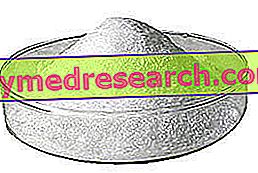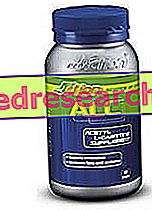The most loved by Italians
Ice cream is one of the favorite foods of the Italians so that, according to a survey commissioned by Eurisko from IGI (the Italian Gelato Institute), 95% of the population likes it. Not only that, among the admirers of this food 39% declare to eat it often, 37% sometimes, while only 19% rarely grants it.
Fresh, tasty and tasty, the ice cream satisfies and excites the palates of millions of people every day. Among these there are some particularly attentive to their own line that fear to cross the thin line between pleasure and transgression. But how many calories does an ice cream have, what is the best way to not give up this pleasure without unpleasant repercussions on one's silhouette?
Nutritional characteristics
The main ingredients of ice cream are fresh milk, sugar and eggs to which are added aromas and specific ingredients (chocolate, cappuccino, strawberry etc.).

The richest fatty ice cream is, at least in general, that of cream. Considering that each gram of lipids provides 9 calories (more than double compared to sugars and proteins), cream-rich ice creams are also the most caloric.
The situation, not only in terms of energy, further worsens if vegetable oils and fats are added during preparation. These ingredients, particularly used in the industrial field for their flavor, are often of poor quality. In addition to enhancing the taste of the product, margarine and vegetable fats increase the creaminess of the ice cream and its "resistance" to high temperatures.
Cream, vegetable oils and fats contain the same number of calories but the latter are clearly inferior from an organoleptic and healthy point of view. Coconut oil is instead saved, rich in medium chain fatty acids which, from a nutritional and health point of view, make it equivalent to butter.
Since milk is one of its main ingredients, ice cream is quite rich in calcium, phosphorus, vitamin A and some B vitamins (essentially B1 and B2). Since industrial ice creams use mainly skimmed milk, the vitamin content declines slightly (especially that of vitamin A).
If among the ingredients of the ice cream the dried fruit appears it increases the content and the lipid quality of the food. The fats from these ingredients are in fact of good quality and belong to the family of mono and polyunsaturated fatty acids (the so-called good fats that, if taken in moderation to replace animal lipids, help to keep cholesterol under control).
In drowning, the addition of high spirits further increases the calories of ice cream.
Homemade Ice Cream
How to prepare a low-calorie ice cream at home
Unfortunately, due to technical issues, ice cream needs a certain "solid mass" (or anhydrous), mainly given by sugar and dextrose, necessary to give the product creaminess and spreadability, avoiding the so-called "ice effect". Dextrose and sucrose are only partially replaceable by thickeners (eg carob flour, inulin) or polyols (such as maltitol); consequently it is really difficult to obtain a good ice cream (which does not look like a popsicle) and light. In our video recipes we have tried to find a compromise, combining traditional ice creams with even lighter and more functional recipes, with less fat and calories (or with more protein, as in homemade protein ice cream without an ice cream maker). Access the video section of ice cream and sorbet recipes, and learn how easy it is to make ice cream at home.
Industrial Vs. Handcrafted
Homemade ice cream is a food preparation brought to the solid and pasty state by mixing and freezing the mixture of ingredients. During freezing, thanks to continuous mixing, air is incorporated that gives softness and creaminess to the ice cream. The main difference that distinguishes the industrial ice cream from the artisan one is the greater incorporation of air. To quantify this characteristic the concept of overrun was introduced, which represents the percentage increase in volume of the frozen mixture. For artisan ice cream the overrun is 40-60%, while for the industrial one it is around 100-130%.
The artisan ice cream stands out for the prevalent use of fresh ingredients, carefully mixed by the craftsman based on his creativity. The use of fresh ingredients increases the perishability of the product that must be sold and consumed within a few days of its production.
However, connoisseurs of artisan gelato should be aware that artisanal is not always synonymous with quality. No one forbids the ice cream maker to use, for example, vegetable fats, aromas and various additives, or replace fresh fruit with juices or freeze-dried.
Calories of ice cream
By clicking on the various types of ice cream it is possible to know, in addition to calories, also the percentage content of carbohydrates, fats and proteins. For the freaks of the line there is also a simple calculation form that in a few seconds returns the meters to go to "burn" the calories provided by the food.
| ICE CREAM TYPE (packaged) | CALORIES (Kcal) | Kjoule * |
| Ice cream, mozzarella covered with strawberry sorbet | 101 | 422 |
| Ice cream, lemon sorbet | 132 | 552 |
| Ice cream, orange popsicle | 137 | 573 |
| Vanilla ice cream | 167 | 701 |
| Ice Cream Cacao | 173 | 725 |
| Hazelnut ice cream | 183 | 767 |
| Stracciatella ice cream | 193 | 806 |
| Cream ice-cream | 189 | 789 |
| Fiordilatte ice cream | 218 | 911 |
| Coffee ice cream | 245 | 1025 |
| Biscuit ice cream with eggnog and chocolate cream | 271 | 1134 |
| Ice cream, cone with cream and chocolate | 291 | 1217 |
| Cream ice cream covered with dark chocolate | 316 | 1324 |
| Ice cream with cream, chocolate flakes and peanuts | 326 | 1365 |
| Data source: Inran: National Research Institute for Food and Nutrition | ||
* One joule equals 4.186 calories
How should ice cream be a friend of the line and health?
To assess the quality of an ice cream and the calories it contains it is very important to read carefully the nutritional values shown on the label. When entering an artisan ice cream shop it is good to make sure that the list of ingredients used is well exposed. If this were not the case, given the legal obligation, it is possible to request it at the ice cream maker.
The ideal ice cream:
A) It must contain few calories.
B) Among its ingredients must not appear margarine or analogues (hydrogenated vegetable fats)
C) If it contains "vegetable oils" without specifying the type, it is necessary to carefully evaluate the product
D) Prefer ice creams that do not contain aromas, dyes, thickeners and emulsifiers generally indicated by the word E followed by the corresponding code. The excessive sweetness, the intense flavor and the access color are all signs that indicate the possible presence of additives
E) in the case of industrial ice cream, in addition to carefully reading calories and ingredients, it is important to evaluate the integrity of the package. If the paper is damaged, most likely that ice cream has undergone thermal shock.
F) Among the ingredients of ice cream that indicate a particular attention to the health aspect of food, we can find maltitol (which brings less calories than sugar and dextrose, compensating for the lack of solid mass of the product), inulin and alternative natural sweeteners such as erythritol or stevia.
G) In the case of high cholesterol, prefer soy ice cream, limiting the portions anyway
Anticellulite Dietary Ice Cream Example
Anti-cellulite ice cream
X Problems with video playback? Reload from YouTube Go to Video Page Go to Video Recipes Section Watch the video on youtube



